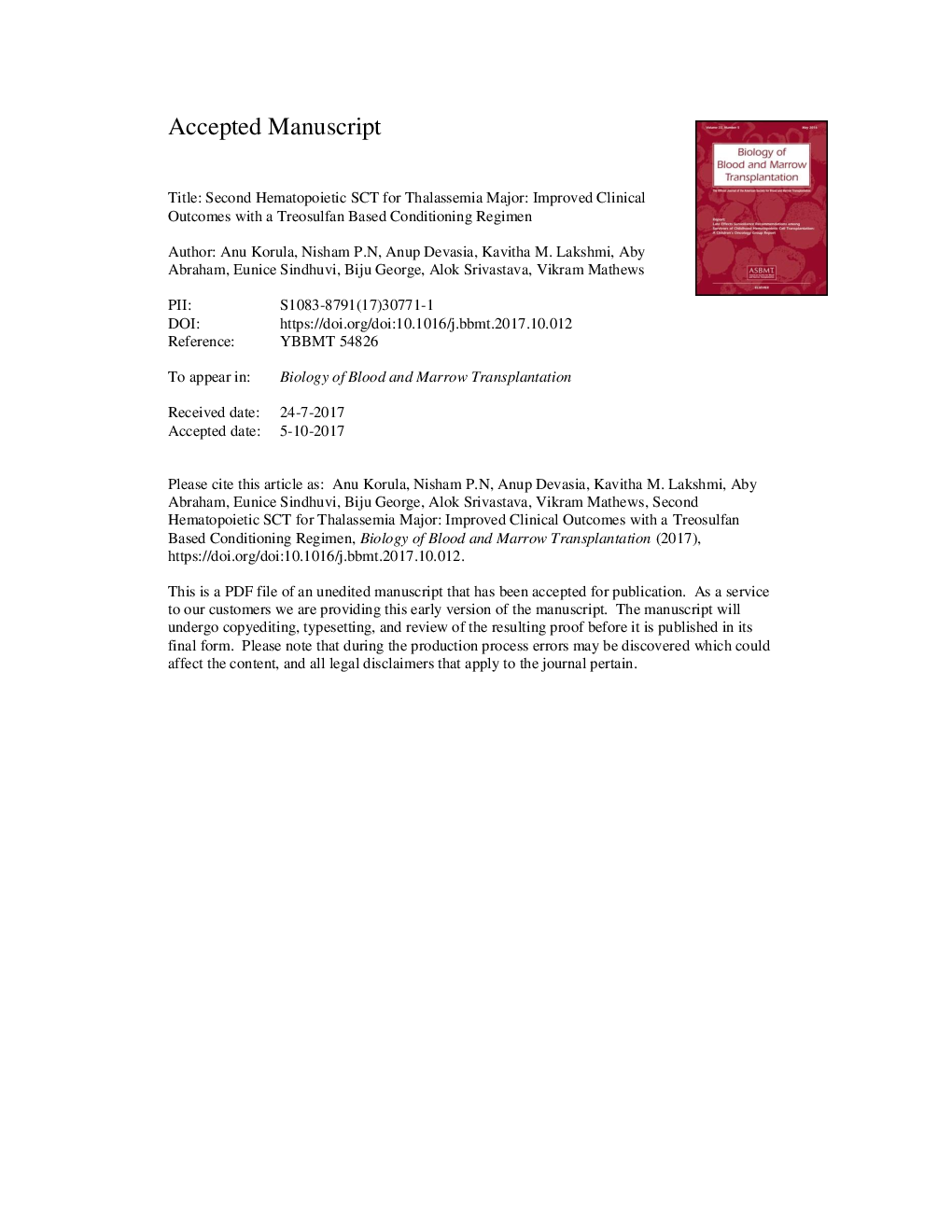| Article ID | Journal | Published Year | Pages | File Type |
|---|---|---|---|---|
| 8430547 | Biology of Blood and Marrow Transplantation | 2018 | 20 Pages |
Abstract
Graft rejection (GR) after allogeneic stem cell transplantation (allo-SCT) occurs in 10% to 20% of patients with β-thalassemia major (TM). There are limited data on the clinical profile and long-term outcome of patients who have had a GR. We undertook a retrospective analysis of patients who had a graft failure after allo-SCT for TM at our center. From October 1991 to June 2016, 55 of 506 patients (11%) transplanted for TM had a graft failure. An additional 7 patients with graft failure after allo-SCT done at other centers were referred to us for a second transplant. The median age was 8 years (range, 1 to 19), and there were 38 males (61.2%). Thirty-two patients (52.4%) were primary graft failures (15 with aplasia and 17 with autologous recovery) and 30 (47.6%) were secondary graft failures (5 with aplasia and 25 with autologous recovery). On conventional risk stratification 40 patients (64.5%) were class III. Seventeen patients (53.12%) with primary graft failure and 16 (53.3%) with secondary graft failure did not receive a second transplant. Twenty-nine patients (46%) with GR underwent a second allo-SCT. With the exception of 1 patient (first allo-SCT with an unrelated cord blood product), the donor for the second transplant was the same as the first transplant. Conditioning regimen for the second SCT was busulfan-based myeloablative (MAC) in 7 patients (24%), treosulfan-based MAC in 12 patients (41.3%), and the remaining received non-MAC regimens in view of pancytopenia and perceived inability to tolerate MAC. None of the patients conditioned with a treosulfan-based regimen had a GR, although 1 patient died with complications secondary to chronic graft-versus-host disease. Of the remaining 17 patients, 10 died after the second GR and 3 of regimen-related toxicity. Four are alive, of which 1 has recurrent TM and the rest are well and transfusion independent at 55, 80, and 204 months, respectively, from second transplant (all busulfan-based MAC). On a univariate analysis a nontreosulfan-based conditioning regimen and time from GR to second transplant of <1 year was significantly associated with an adverse impact. However, on a multivariate analysis only a nontreosulfan-based regimen was associated with a significant adverse impact on event-free survival (HR,â11.5; 95% CI, 1.13 to 116.4; Pâ=â.039). In conclusion, there has been a significant improvement in clinical outcomes in our experience with the use of a treosulfan-based reduced-toxicity MAC regimen for second allo-SCT for TM. It would be reasonable, where feasible, to defer the second transplant by a year after the first GR.
Related Topics
Life Sciences
Biochemistry, Genetics and Molecular Biology
Cancer Research
Authors
Anu Korula, Nisham PN, Anup Devasia, Kavitha M. Lakshmi, Aby Abraham, Eunice Sindhuvi, Biju George, Alok Srivastava, Vikram Mathews,
